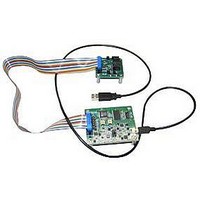EVAL-AD5422EBZ Analog Devices Inc, EVAL-AD5422EBZ Datasheet - Page 36

EVAL-AD5422EBZ
Manufacturer Part Number
EVAL-AD5422EBZ
Description
BOARD EVAL FOR AD5422
Manufacturer
Analog Devices Inc
Specifications of EVAL-AD5422EBZ
Number Of Dac's
1
Number Of Bits
16
Outputs And Type
1, Single Ended
Sampling Rate (per Second)
1M
Data Interface
Serial
Settling Time
32µs
Dac Type
Current/Voltage
Voltage Supply Source
Analog and Digital, Dual ±
Operating Temperature
-40°C ~ 85°C
Utilized Ic / Part
AD5422
Silicon Manufacturer
Analog Devices
Application Sub Type
DAC
Kit Application Type
Data Converter
Silicon Core Number
AD5422
Kit Contents
Board And Literature
Lead Free Status / RoHS Status
Lead free / RoHS Compliant
AD5412/AD5422
The power supply lines of the AD5412/AD5422 should use as
large a trace as possible to provide low impedance paths and
reduce the effects of glitches on the power supply line. Fast
switching signals such as clocks should be shielded with a
digital ground to avoid radiating noise to other parts of the
board. Never run these near the reference inputs. A ground line
routed between the SDIN and SCLK lines helps reduce crosstalk
between them (this is not required on a multilayer board that
has a separate ground plane, but separating the lines helps). It
is essential to minimize noise on the REFIN line because it
couples through to the DAC output.
Avoid crossover of digital and analog signals. Traces on
opposite sides of the PCB should run at right angles to each
other. This reduces the effects of feed through the board. A
microstrip technique is by far the best but not always possible
with a double-sided board. In this technique, the component
side of the board is dedicated to the ground plane, and signal
traces are placed on the solder side.
THERMAL AND SUPPLY CONSIDERATIONS
The AD5412/AD5422 are designed to operate at a maximum
junction temperature of 125°C. It is important that the devices
not be operated under conditions that cause the junction
temperature to exceed this value. Excessive junction tempera-
ture can occur if the AD5412/AD5422 are operated from the
maximum AV
directly to ground. In this case, control the ambient temperature
or reduce AV
At the maximum ambient temperature of 85°C, the 24-lead
TSSOP package can dissipate 950 mW, and the 40-lead LFCSP
package can dissipate 1.42 W.
Table 25. Thermal and Supply Considerations for Each Package
Considerations
Maximum Allowed Power
Dissipation When Operating
at an Ambient Temperature
of 85°C
Maximum Allowed Ambient
Temperature When
Operating from a Supply of
40 V and Driving 24 mA
Directly to Ground
Maximum Allowed Supply
Voltage When Operating at
an Ambient Temperature of
85°C and Driving 24 mA
Directly to Ground
DD
DD
. The conditions depend on the device package.
while driving the maximum current (24 mA)
TSSOP
T
T
T
AI
J
J
J
max
max
max
DD
θ
JA
×
−
−
−
θ
T
T
P
JA
D
A
A
×
=
=
θ
125
. 0
125
JA
028
42
=
−
−
125
×
85
85
42
−
=
=
(
950
40
34
Rev. C | Page 36 of 40
×
V
mW
. 0
028
)
×
42
To ensure that the junction temperature does not exceed 125°C
while driving the maximum current of 24 mA directly into
ground (also adding an on-chip current of 3 mA), reduce AV
from the maximum rating to ensure that the package is not
required to dissipate more power than previously stated (see
Table 25, Figure 75, and Figure 76).
=
78
Figure 75. Maximum Power Dissipation vs. Ambient Temperature
°
Figure 76. Maximum Supply Voltage vs. Ambient Temperature
C
2.5
2.0
1.5
1.0
0.5
45
43
41
39
37
35
33
31
29
27
25
0
40
25
LFCSP
T
T
T
AI
J
J
J
max
max
max
45
DD
θ
35
JA
×
−
θ
−
−
50
T
JA
T
P
A
A
AMBIENT TEMPERATURE (°C)
AMBIENT TEMPERATURE (°C)
D
=
=
×
55
45
. 0
125
125
θ
028
JA
28
−
60
−
=
×
LFCSP
TSSOP
85
125
85
28
55
65
=
=
−
. 1
51
(
42
40
V
70
65
W
×
. 0
028
75
TSSOP
75
)
×
80
LFCSP
28
=
85
85
94
DD
°
C




















